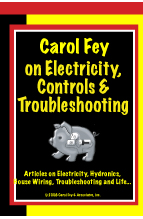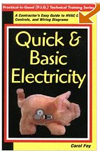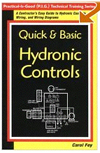by Carol Fey
A quick definition of aquastats and their specifications.It's
no mystery that an aquastat is a control that goes with a boiler.
If you don't know much more about it than that, though, you
have a lot of company. There seems to be confusion about exactly
what an aquastat does, and especially about finding a replacement
when one fails.
An aquastat does the same thing as a thermostat. But an aquastat
senses and controls water temperature, whereas a thermostat
does air. In hydronic heating we use both - the aquastat to
control boiler water temperature, and the thermostat to control
room temperature.
There are two parts to the word - "aqua" and "stat."
Aqua means water. Stat means switch. An aquastat is just a switch
that turns the boiler on and off to maintain the right water
temperature.
An aquastat is made up of only three simple parts: a switch,
a temperature-sensing element (also called a bulb), and a capillary
tube that connects the two. The bulb and capillary tube are
filled with a temperature-sensitive substance called fill. The
bulb is inserted in the water. As the fill in the bulb is heated
by the water, it expands through the tube and exerts pressure
on the switch. Pressure changes cause the switch to open or
close, which turns the boiler off or on.
An aquastat usually comes with the boiler. You don't need to
know much about it until it fails. Then the problem can be finding
a replacement. Perhaps you can't find a direct replacement because
the part number on the old aquastat doesn't match anything available
at the parts distributor.
That may happen because the aquastat that comes with the boiler
has a part number unique to that boiler manufacturer. It's likely
that a trade, or generic, replacement will work. But how can
you tell what's a suitable replacement if the numbers don't
match perfectly? You're stuck with matching the specifications.
Here's what you need to know to match specifications: bulb type,
capillary length, operating range, differential, application,
reset and switching action. Hold onto your plumber hats - we'll
look at these one at a time. Here we go!Bulb Type
There are only three bulb types:
# An immersion bulb is placed directly into the boiler water.
It's often put in a metal sleeve called a well. A gray sticky
substance called conductive compound is often put in the well
along with the bulb to assure heat transfer.
# A strap-on bulb is mounted outside the boiler, often on a
supply pipe. It's easier to install, but temperature sensing
may be less precise.
# A remote bulb has a capillary tube several feet long so that
the bulb and the controller can be apart.
Capillary Length: If the bulb is remote, the capillary tube
has to be long enough to get to the controller. No, you can't
stretch it.
Operating Range: The temperature you want for the boiler water
must be within the operating range. An example of a range is
100 degrees F to 240 degrees F.
Differential: This is the difference in degrees between the
highest and lowest allowable boiler water temperature. If you
tried to maintain an exact temperature, the boiler would be
turning on and off all the time. The bigger the differential,
the less often the boiler will fire, and it will run longer
when it does. A differential will be either fixed, for example
10 degrees (you don't get to choose), or adjustable, for example
10 to 25 degrees (you get to choose within that range).
Application: An aquastat serves one or more of these functions:
# High limit - The aquastat turns off the boiler if the water
temperature reaches the high-limit setpoint, even if there's
a call for heat.
# Circulator control - The aquastat turns on the circulator
if boiler water temperature reaches this temperature.
# Low limit - If the water temperature drops to this point,
the aquastat will bring on the burner to heat the water, even
if there's no call for heat from the room thermostat.
# Reset - Either automatic (after high limit is reached, the
burner can come on again as soon as the water temperature drops),
or manual (a person has to come and push the controller reset
button to get the burner to function again after a high limit).
This is for extra safety.
Switching Action: Every switch has a switching action. For a
detailed explanation, see my column "Switches Is Just Switches,"
March 2003. Keep in mind that "make" means that the
switch makes contact, completes the circuit and "turns
on" whatever it's controlling. "Break" means
the switch breaks contact and "turns off" whatever
it's controlling. "Contacts make on temperature rise."
As the temperature rises, the switch turns on the equipment.
This is the action of a circulator control. When the temperature
rises to the setpoint, the switch closes (makes) to turn on
the circulator. "Contacts break on temperature rise."
As the temperature rises, the switch turns off the equipment.
This is the action of a high limit. When the temperature rises
to the setpoint, the switch opens (breaks) to turn off the burner
# SPST - The switching action of most aquastats is the same
as an ordinary household light switch. You can turn one thing
on or off.
# SPDT - The switching action of a few aquastats allows you
to control two things at once. As you turn one on, you turn
the other off, and vice versa.
If this make/break, rise/fall stuff makes your head spin, try
thinking of how the temperature is controlled in your home or
office. In the winter, the thermostat "makes" on temperature
fall. That is, when the temperature falls to the thermostat
setpoint, the switch inside the thermostat "makes"
contact and turns on the heat.
In the summer, the thermostat "makes" on temperature
rise. When the temperature rises to the thermostat setpoint,
the switch inside the thermostat "makes" contact and
turns on the cooling.
High limit, low limit and circulator control are all separate
functions of single-function aquastats. You could have a separate
aquastat control each. The household comparison is that you
can have a thermostat for heating, and a completely separate
thermostat for cooling. But it just makes sense to control both
with the same thermostat.
But why have a separate control for each function when you could
have them all in one? Multiple-function aquastats come especially
designated for high and low limit, high limit and circulator
control, and high limit, low limit and circulator control.
Triple aquastat relays are an aquastat, a relay and a transformer
all in one box. When you look inside the controller, you can
see that there actually is one of each control. This is a multiple-function
aquastat.
Electronic aquastats do the same thing as the old-fashioned
type. The difference is that in the bulb is an electronic thermister.
Instead of a capillary tube, a wire is used to send a signal
from the thermister to the switch.
Now you know a lot more about aquastats. They're just on-and-off
switches that control water temperature. How simple can you
get? |




